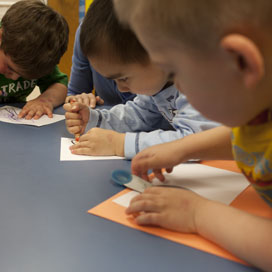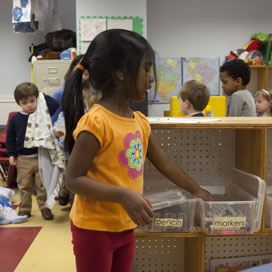
Set up a project in the Art Center where the children make a place mat with construction paper cutouts of a place setting – plate, cup, spoon, fork, and napkin. Have them glue the pieces into the correct place on a large piece of construction paper. Laminate or cover them with contact paper. Use the placemats at lunchtime. As children help you set the table, remind them to place the pieces in the correct places according to the placemats.
 This activity will help the children understand routines, and to identify order and shapes, and how to work cooperatively with their peers. Using the placemats during lunchtime will help the children set the table correctly, thus pleasing themselves and you.
This activity will help the children understand routines, and to identify order and shapes, and how to work cooperatively with their peers. Using the placemats during lunchtime will help the children set the table correctly, thus pleasing themselves and you.

Allow the children to choose which center they would like to visit. Ask them questions about what they will do when visiting and why they want to go there. As you visit the centers, discuss the children’s goals with them and remind them of what they were planning to do.
 This activity will teach the children to set goals for their learning. The children will have to learn to problem-solve and to understand that their actions affect themselves and may affect others. Discussing their decisions will help them build their oral language development.
This activity will teach the children to set goals for their learning. The children will have to learn to problem-solve and to understand that their actions affect themselves and may affect others. Discussing their decisions will help them build their oral language development.

Set up rules in the classroom, such as children must clean up an activity when they have finished working. Make the task easier for them by having your shelves and room labeled with pictures and words of where materials belong. Assign the job of “Supervisor” to a child to make sure things are put back correctly at the end of center time.
 Children will benefit from the structure and routine of your program. They will learn to identify common words by matching pictures and their names. Giving the children responsibility will build their confidence and self-esteem. They will learn to get along with their peers and adults.
Children will benefit from the structure and routine of your program. They will learn to identify common words by matching pictures and their names. Giving the children responsibility will build their confidence and self-esteem. They will learn to get along with their peers and adults.
